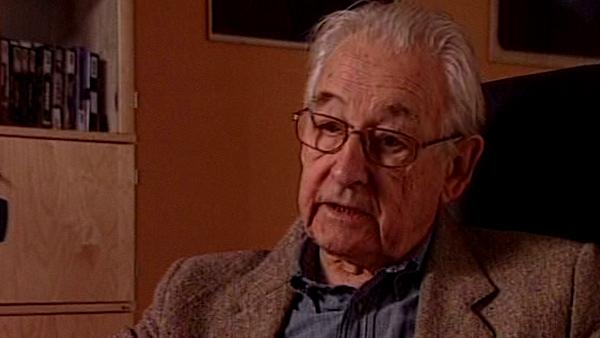NEXT STORY

Landscape after Battle: The title
RELATED STORIES

NEXT STORY

Landscape after Battle: The title
RELATED STORIES


|
Views | Duration | |
|---|---|---|---|
| 101. New topics for films | 63 | 01:30 | |
| 102. Landscape after Battle | 71 | 01:55 | |
| 103. Landscape after Battle: The actors | 43 | 03:08 | |
| 104. Landscape after Battle: The title | 55 | 04:48 | |
| 105. Landscape after Battle: After the premiere | 45 | 01:30 | |
| 106. Film about Pilate | 39 | 02:14 | |
| 107. Pilate - a story from Bulgakov's The Master and... | 58 | 04:31 | |
| 108. Transferring an ancient tale into the new, free world | 51 | 04:22 | |
| 109. The film about Pilate is a film about our moral responsibility | 39 | 04:30 | |
| 110. A Film for Good Friday | 44 | 01:11 |


I decided that the main character in the film could be played successfully by Daniel Olbrychski, who had accompanied me professionally for many years. This might be interesting. Daniel was of an athletic build, very well defined whereas I needed someone who seemed a bit deflated, someone who after his prison experiences... like an intellectual who's trying to find himself in this new reality. I have to say that to a great degree - this might be interesting - to a great degree the costume played a very important role, which the set designer and the costume designer with whom I'd worked frequently on, among other things, Ashes, and who also worked in theatre, found a wonderful and completely unexpected solution. I'm referring to Jerzy Szeski. While the test shots were being taken, he found a pullover which he'd taken off one of the builders who was working in the studios and suddenly he brought this pullover which was all matted, neither red nor green but which hid the strong, muscular contours of Daniel Olbrychski's body and made it possible for him to play someone completely different. This is interesting because sometimes if the costume is picked at the right moment, when the character is being defined, this helps the actor to understand who he's playing. And this is what happened. It was harder to find the female lead for this film, Daniel Olbrychski's partner. After many events, which I won't go into, I finally decided that it should be a young actress who was only just beginning her acting career, who had only just joined drama school, Stanisława Celińska, who turned out to have an amazing talent, capricious, as if she had been especially chosen for this film. She had a sense of tragedy. She played a Jewish girl who's trying to get away from this world of German camps and she goes to Israel, not really knowing to whom nor what she can expect along the way.
Do tego filmu też myślałem, że postać głównego bohatera może odtwarzać z powodzeniem Daniel Olbrychski, który towarzyszył mi już od wielu lat. I to może ciekawe jest, że Daniel był atletycznej budowy, takiej wyrazistej bardzo. A tu potrzebowałem kogoś takiego zgaszonego, kogoś po tych przejściach wojennych, jakby intelektualistę, który próbuje się odnaleźć w tej nowej rzeczywistości. I... i muszę powiedzieć, że w dużym stopniu to jest ciekawe może, w dużym stopniu ważną rolę odegrał kostium, który scenograf i kostiumolog, z którym pracowałem wielokrotnie, między innymi w filmie Popioły, który też pracował wiele w teatrze, odnalazł... znalazł jakieś wspaniałe i niespodziewane zupełnie, zaskakujące rozwiązanie. Mówię o Jerzym Szeskim. W czasie zdjęć próbnych znalazł jakiś sweter, który zdjął z ktoregoś z budowlanych robotników, którzy tu pracowali na terenie wytwórni i nagle przyniósł ten taki sweter, strasznie taki sfilcowany, ni to czerwony, ni to zielony, no i on dobrze skrył właśnie to umięśnienie, silną taką, że tak powiem, sylwetkę Daniela Olbrychskiego i pozwolił mu zagrać człowieka zupełnie innego. To ciekawe, bo czasem właśnie kostium w porę dobrany, wtedy kiedy tworzy się postać, pomaga aktorowi też zrozumieć kogo gra. I to się właśnie tak stało. Trudniejsza sprawa była ze znalezieniem aktorki dla tego filmu, partnerki Daniela Olbrychskiego. No, po historiach, o których nie będę opowiadał, wreszcie zdecydowałem, że powinna nią być młoda, zupełnie począkująca aktorka, która ledwie przyszła do szkoły teatralnej – Stanisława Celińska, która okazała się być zupelnie zdumiewającym talentem, kapryśnym takim. No, właśnie jakby specjalnie dla tego filmu wybranym. Z takim poczuciem tragizmu. Grająca Żydówkę, która gdzieś próbuje z tego świata niemieckich obozów wydostać się i gdzieś jedzie do Izraela, nie bardzo wiedząc do kogo i nie bardzo wiedząc co ją tam po drodze czeka.
Polish film director Andrzej Wajda (1926-2016) was a towering presence in Polish cinema for six decades. His films, showing the horror of the German occupation of Poland, won awards at Cannes and established his reputation as both story-teller and commentator on Poland's turbulent history. As well as his impressive career in TV and film, he also served on the national Senate from 1989-91.
Title: "Landscape after Battle": The actors
Listeners: Jacek Petrycki
Cinematographer Jacek Petrycki was born in Poznań, Poland in 1948. He has worked extensively in Poland and throughout the world. His credits include, for Agniezka Holland, Provincial Actors (1979), Europe, Europe (1990), Shot in the Heart (2001) and Julie Walking Home (2002), for Krysztof Kieslowski numerous short films including Camera Buff (1980) and No End (1985). Other credits include Journey to the Sun (1998), directed by Jesim Ustaoglu, which won the Golden Camera 300 award at the International Film Camera Festival, Shooters (2000) and The Valley (1999), both directed by Dan Reed, Unforgiving (1993) and Betrayed (1995) by Clive Gordon both of which won the BAFTA for best factual photography. Jacek Petrycki is also a teacher and a filmmaker.
Tags: Landscape after Battle, Ashes, Daniel Olbrychski, Jerzy Szeski, Stanisława Celińska
Duration: 3 minutes, 8 seconds
Date story recorded: August 2003
Date story went live: 24 January 2008